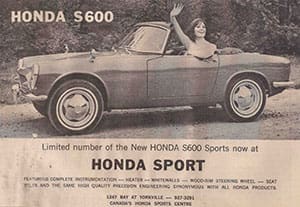Honda EV investment represents a significant expansion from its humble beginnings in the Canadian market
 The announcement that Honda will be building a battery plant and an assembly plant for electric vehicles near Alliston, Ontario, is the latest chapter in Honda’s history in Canada.
The announcement that Honda will be building a battery plant and an assembly plant for electric vehicles near Alliston, Ontario, is the latest chapter in Honda’s history in Canada.
Honda announced on Apr. 25 that it will be making a $15-billion investment to build electric vehicles and a stand-alone EV battery plant at Honda’s facility in Alliston, Ontario, about an hour’s drive north of Toronto. It’s being billed as the largest auto investment in Canada’s history. It will mean 1,000 new jobs. The federal and Ontario governments are each providing $ 2.5 billion in direct and indirect incentives.
This announcement represents substantial growth from Honda’s humble beginnings in the Canadian market.
In the early 1960s, Honda was one of the best-known motorcycle brands in Canada. It was something of a surprise when the firm announced it was branching out and would sell automobiles.
 The Honda manufacturing facility in Alliston, Ontario, is about to undergo a massive addition. |
 Honda cars went on sale in Canada in Toronto in 1965, and were was aimed at Fiat, MG, Sunbeam and Triumph. |
 The earliest Honda automobiles in Canada were two-seaters, first a convertible and then a coupe. |
The first Honda cars came to Canada in May 1965, when six vehicles were delivered to customers in Toronto. Then, in August, another 100 Honda cars arrived in Toronto.
They were tiny cars with power from a 600 cc engine – just 37 cubic inches – that produced 57 horsepower.
One newspaper ad of the era read: “Even though small, the Honda has all the features of a sports car such as two-speed windshield wiper with washer, easy-to-read dashboard, steering wheel lock, comfortable driving position, roll-up side windows, lockable fuel cap, spacious trunk room, wind deflector, one-push convertible top, plenty of legroom, etc.”
In those days, there was no such thing as Honda Canada, which wasn’t created until 1969. Before that, independent distributors imported Honda cars from Japan.
By the late 1970s, Honda was the best-selling imported car in Canada.
Then, in June 1984, Honda announced it would build its first assembly plant in Canada. At the time, Honda had only one other assembly plant in North America, in Marysville, Ohio.
Honda considered several communities before deciding on Alliston because of its proximity to good rail and road transportation and U.S. suppliers.
The $100-million Alliston plant would produce about 40,000 vehicles annually and would mean jobs for 350 people when production got underway. Unlike many auto plants, Honda did not seek any government funding for this project.
Ground on the new plant was broken on Nov. 2, 1984, with Honda president Tadashi Kume on hand. With construction continuing a year later, Honda announced far bigger plans for Alliston, saying it would double investment to $ 200 million, production would be doubled to 80,000 units annually by 1989, and staff would be increased to 700, with Kume citing “ increased confidence and strong local support for the investment expansion.”
Two years later, on Nov. 3, 1986, the first Honda, a grey Accord, rolled off the Alliston assembly line. This Accord had about 20 percent Canadian content. About 80 percent of the stamped metal parts came from the Honda plant in Marysville, Ohio, and the engine and transmission came from Japan.
In January 1988, Honda announced an $80-million expansion to the Alliston plant. This would mean that the Civic hatchback model would be assembled in North America for the first time. A new stamping plant would be built as well. The first Civic hatchback, a white one, rolled off the assembly line in Alliston on Apr. 7, 1988.
In December 1995, Honda announced it would spend $ 400 million to expand the Alliston plant, creating 1,000 jobs. The expansion would add a capacity of 50,000 to 100,000 vehicles per year and allow a new minivan to be built in Alliston. The plant was already turning out about 100,000 Odyssey minivans annually. Again, no government subsidies were requested or provided.
During the next few years, there were more expansions to the Alliston plant to meet changing market demands.
With this latest announcement of a $15-billion investment to build an EV battery plant and an EV vehicle assembly plant, Honda is set to build cars and parts in Canada for a long time.
Dale Johnson is an award-winning author, broadcaster and journalist who has worked in TV, radio, print and online. While the manufacturer provided Dale with a vehicle to test drive, the content of this review was not reviewed or accepted by the manufacturer.
For interview requests, click here.
The opinions expressed by our columnists and contributors are theirs alone and do not inherently or expressly reflect the views of our publication.
© Troy Media
Troy Media is an editorial content provider to media outlets and its own hosted community news outlets across Canada.

